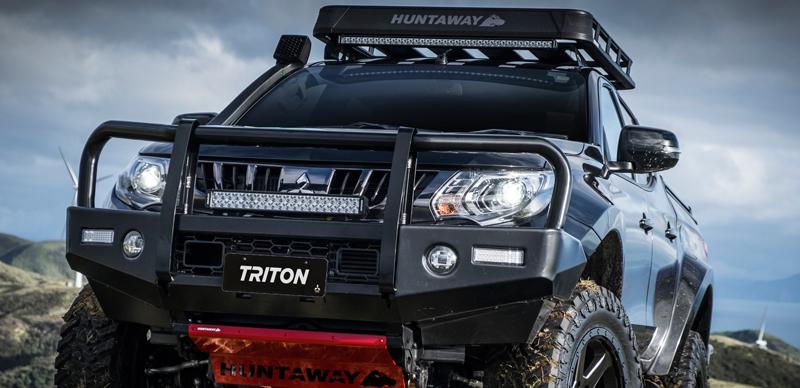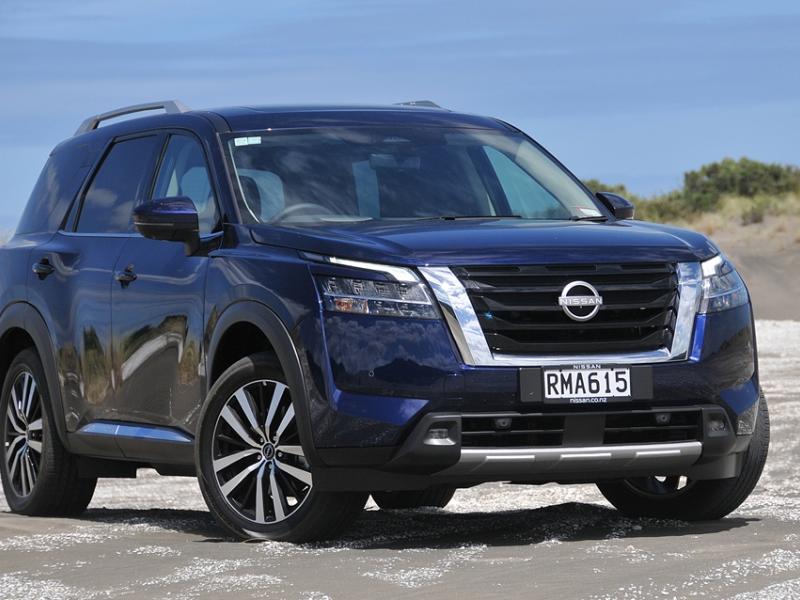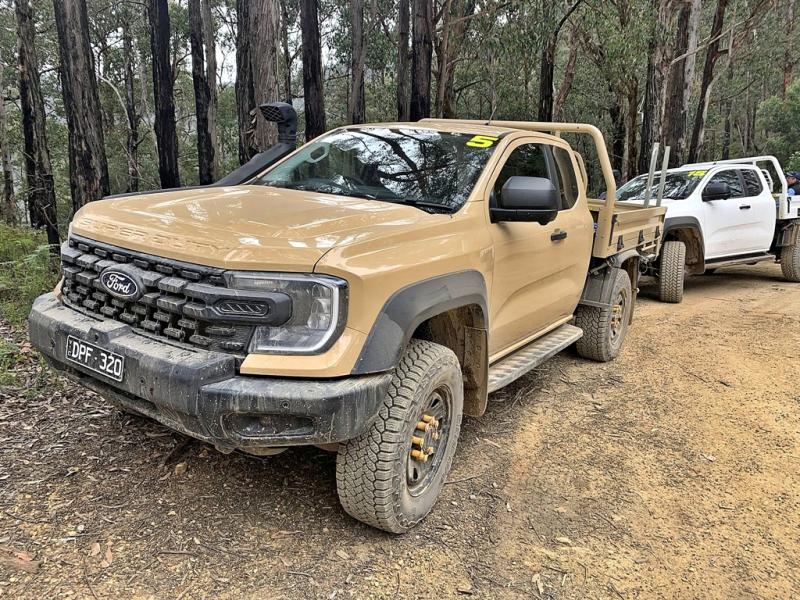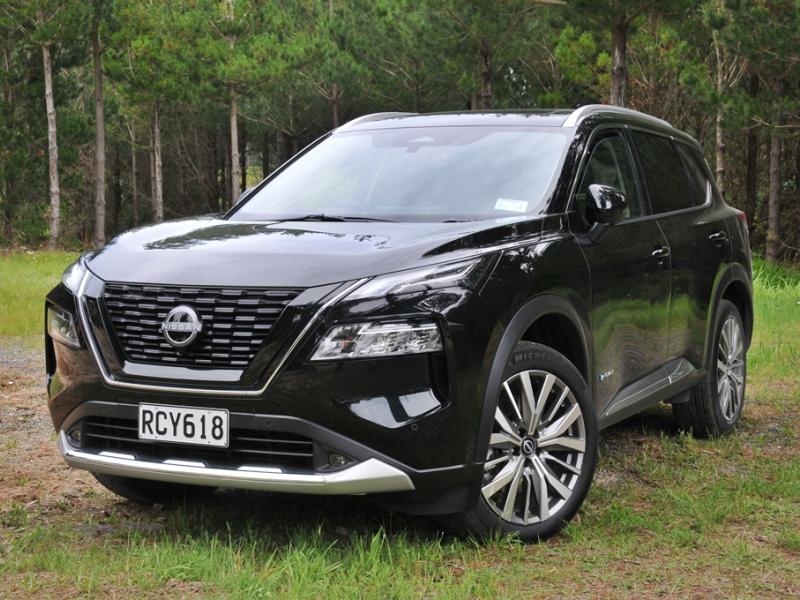Mitsubishi’s modified Huntaway proved a hit at Fieldays this year. NZ4WD editor Ross MacKay explains why.
These days every second 4WD ute you see seems to have – at the very least – a set of after-market wheels and tyres; so it is getting harder and harder for manufacturers to make their latest and greatest models stand out from the crowd.
Or at least it was until Mitsubishi Motors NZ GM of vehicle sales and marketing Daniel Cook sat down with a small team of fellow company staff members and came up with a plan to focus attention on its Triton line.
“The idea,” says Cook, “was to build a show truck for Fieldays. Something – if you like – to attract people to our stand and to inspire them, perhaps, to build their own version.”
With a wide range of 2 and 4WD models with both wellside and cab/chassis options, perky 2.4 litre turbo-diesel engine, manual or automatic transmissions, braked towing capacity of up to 3100kg, quoted payload of up to 965kg and one of the best warranties in the business, Mitsubishi regularly sells over 600 Tritons a month here.
Think ‘tuff truck’ however and you don’t immediately think ‘Triton. Sure there are plenty in use on (and off) our roads. But you simply don’t see as many dealer and/or owner-modded examples as you do Rangers, Hiluxes and even Amaroks.
Which got Cook and co thinking about building their own ‘tuffed-up Triton.’
The result was the Huntaway, a long, tall, broad-shouldered special edition ‘beast’ which has captured the imaginations of 4WD ute fans form Kaitaia to Bluff – and very possibly beyond.
The promo video alone had had 350,000 views (at the time of writing) and the feedback from Fieldays – where the so-far one-off Huntaway took pride of place on Mitsubishi’s stand – was nothing short of incredible.
“We were looking for something to inspire people and that’s exactly what Huntaway has done,” says Cook. “We have been absolutely inundated with customer enquiry.”
Obviously, a lot of that enquiry was along the lines of ‘wow, that’s exactly what I want, where do I go to buy one?’ But Cook says that that is only part of the picture.
“When we put the ad on TV the level of enquiry at dealerships around the country was incredible. However, because it is not a production model, they couldn’t actually ‘sell’ a Huntaway. But by showcasing what you can do to any Triton model, it allowed the dealer to open a conversion along the lines of, ‘buy this model and you can do this, this, and this.’
Because turbo-diesel double cab utes are such hot market property at the moment you didn’t need a degree in rocket science to work out what to build a ‘show truck’ around, particularly one with Fieldays in mind.
What stand’s the Huntaway apart – initially anyway, however – is its stance, and integrated blister-style wide-body kit.
Keep looking and it’s the attention to detail, the amount of thought and care that has gone into each and every mod, plus the integrated ‘factory-like’ conception and execution that impresses.
Examples are everywhere, from the signature red Brembo disc brake upgrade to the seamless way the standard fuel cap integrates with the extended rear guards.
It’s no ‘trailer queen’ either, all mods signed off and certified and the vehicle itself registered and warranted and able to be driven on the road like any other Triton.
Every project has to start somewhere, of course and in the Huntaway’s case it was with the wheels and tyres,
‘When we started,” says Cook, “we had rough idea of what we wanted to achieve. It was like, ‘OK we are going to build a concept ute, here are a few features it could have.’”
Key to the initial look were a set of aftermarket wheels and tyres and - as it turned out - everything else ‘sort of evolved from there.’
“There was definitely an evolution from where we started to where we ended up with,” agrees Nathan Thomas, the company’s national technical service advisor and staff member who did most of the running around associated with the build.”
Early on, for instance, talk centred around using a cab/chassis Triton with a custom alloy flat deck on the back. But time scuppered that idea.
And surprisingly, perhaps, the decision to create a bespoke set of wide-body guards actually came quite late in the piece.
“Initially,” says Thomas, “we were talking about some sort of big bolt-on flares to cover the wheels but then we started to talk about a wide body look and when Dan said yes I got Customs Body Shop in Upper Hutt involved.”
Typical of the close-knit and collaborative nature of the Kiwi (and particularly the greater Wellington) car scene the man behind Customs Body Shop, Ben Martin, is an old friend of Thomas and the pair were soon at work, cutting, trial fitting and trimming bits of wide body guard to suit.
“One of my big things throughout the build,” says Thomas, “was that I wanted everything to tie in. I think with a lot of people when they build something like this the vehicle looks a bit ‘bitsy.’ So it was important to me that that the Huntaway had a single, coordinated ‘factory’ look.
In typical ‘artisan’ fashion Thomas and Martin did most of the work ‘on the fly,’ eschewing drawings in favour of a practiced eye and good old fashioned trial and error.
“We did give him (Martin) a Pajero Sport guard so he had an idea of the particular look I wanted to achieve around the front guard,” says Thomas. “Otherwise it was just stick stuff on the vehicle and keep evolving it until it looked right.”
Filling the wide-body guards out nicely are a suitably stout set of Fuel Ripper 20 inch dia. alloy wheels and 35 in. Atturo Trail Blade M/T tyres from DTM. At the start of the process there was a – brief – discussion about whether to go for 33 or 35 in. tyres. But that’s all it was, and the decision was made to go the 35 in. way.
Though they bolted up fine first time, the look Thomas was after saw him investigate widening the track. A call to the certifier confirmed that, yes he could do so using wheel spacers up to 30mm wide each side.
As it turned out the only suitable ones measured 27mm – but that turned out to be more than enough, when, with the extra offset in the wheels, the overall gain was 60 mm per side (120mm all up front & rear.
This in turn led to the eventual lift height - of just over 100mm (four inches in the old money) – achieved via a combination of suspension (25mm strut spacers up front and 50mm lift blocks at the rear) and body lift.
Up front the suspension units themselves remain factory, but at the back a set of longer aftermarket RAW shock absorbers were recommended and supplied by Autolign Petone.
“The key there was the longer extension, “ says Thomas. “Because of the lift height the factory shocks didn’t extend far enough so we had to go for a (longer) aftermarket option.”
While some keyboard warriors might question the need for a body lift (rather than a simple suspension kit) Thomas says it made sense on a number of levels.
“The key point is that I wanted it to still drive like a factory Triton. My thinking is that you keep the suspension as close to standard as possible for road manners and raise the body for clearance. It’s the way I’ve done it with my own builds in the past and it has always worked really well for me.”
The decision was vindicated early on in the process, when the only two things Thomas had to modify were the top radiator hose (it need to be slightly longer) and the mounts for the heater hoses.
“When you lift a body you have to be aware of things like radiator fan clearance, steering shafts from the chassis and hard brake lines and hoses.
“The good thing with the Triton in terms of the latter (brake lines) s that they have big coils and when you lift the body the coils unwind so from that perspective the job was fantastically easy.”
With its distinctive mix of soft shell curves and contrasting sharp-edged creases the Triton is hard to mistake for any of the other turbo-diesel double cab utes currently on sale here. Rather than stress over it, however, Thomas and Martin made a virtue of the fact.
“ What I had in mind, “ says Thomas, “was a sort of factory wide-body look along the lines of the old Pajero Evo.”
It was Mitsubishi’s other Evo line, the rally one, also provide both inspiration and hardware for a brake upgrade.
“My personal opinion,” says Thomas, “ is that if you have big wheels with drums behind them it just looks wrong, so I wanted to get away from that. Also, with Mitsubishi and Brembo having such a strong heritage with their Evo models we decided that it had to have Brembo calipers on the front and discs at the rear as well.”
The result was a best-of-both-worlds solution which Pajero Sport rotors (320mm up from the Triton’s standard 295mm) with Evo 8 callipers at the front, and Pajero Sport rotors and calipers at the rear.
Finishing off the ‘contemporary tuff truck’ look were a range of accessories like the factory MMC snorkel, TJM front bar, MCC rear bar, Fully Equipped Trade Top (with 50kg-rated rails) and Pioneer Roof Tray from Rhino Rack.
Interestingly enough some punters at Fieldays queried the inclusion of the roof tray. A winch was also part of the original spec discussion but – though there is room and provision for one – didn’t make it to the final build sheet.
After such a positive reception – both on line and at Fieldays – the Huntaway is now on a dealer tour and will also be displayed at other Fieldays-type events around the country before being delivered to its proud - not to mention patient - new owner.
To read every story in the September 2017 issue of NZ4WD go to Zinio.com (August 18) or purchase your own hard copy at the Adrenalin store.







